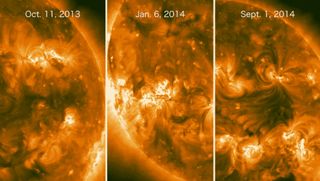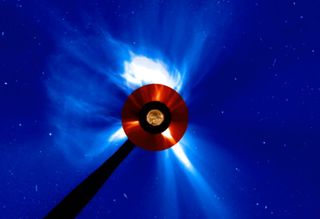'Hidden' Solar Flares Linked to High-Energy Gamma-Rays for 1st Time
Solar eruptions hidden by the light of the sun are releasing bursts of energy roughly 30 times more powerful than ever seen before, and for the first time, an international team of scientists has associated these hidden flares with high-energy gamma-rays.
Using NASA's Fermi Gamma-ray Space Telescope in combination with its Solar Terrestrial Relations Observatory (STEREO) — a pair of satellites that image the sun in orbits ahead of and behind Earth's — the researchers were able to connect the powerful gamma-ray explosions with bursts of material launched into space. The explosions, known as coronal mass ejections (CMEs), occurred on the far side of the sun, but the gamma-rays traveled along magnetic-field lines to the near side, the researchers said in their new study.
"Fermi is seeing gamma-rays from the side of the sun we're facing, but the emission is produced by streams of particles blasted out of solar flares on the far side of the sun," study co-author Nicola Omodei, a researcher at Stanford University in California, said in a statement. Omodei presented the results Jan. 30 at the American Physical Society meeting in Washington, D.C. [Video: Far-Side Solar Storms Unleash Gamma-Rays, Detected by Fermi]

"These particles must travel some 300,000 miles [500,000 km] within about 5 minutes of the eruption to produce this light," Omodei said.
The big picture
On Oct. 11, 2013, the STEREO satellites spotted a massive solar flare burst from the far side of the sun. Only 20 minutes later, Fermi's Large Area Telescope (LAT) observed a spike in gamma-ray emission on the near side that lasted nearly half an hour, the researchers said. Two more powerful flares were observed by STEREO in January and September 2014, with the gamma-ray emission from the second lasting nearly an hour. Because the flares occurred around the edge, or limb, of the sun, they are known as behind-the-limb flares.
In each case, billion-ton clouds of plasma from the sun were ejected into space, with the CME from the most recent event moving away from the sun at nearly 5 million mph (8 million km/h), according to the researchers. In solar flare classification, X-class flares are the most powerful, and M-class flares are just behind them. Both 2014 flares were X-class flares, whereas the 2013 event was an M-class burst, the researchers noted. [Video: What is a Solar X-Flare? Sun's 'Richter Scale' Explained]

But not all of the material left the sun. Magnetic-field lines run across the solar surface, attracting charged particles. In this case, the researchers said, the particles released on the sun's far side must have traveled to the near side along those field lines before hitting the surface and generating gamma-rays.
Get the Space.com Newsletter
Breaking space news, the latest updates on rocket launches, skywatching events and more!
The Fermi telescope has measured the high-energy emission of more than 40 solar flares in its first eight years of operation. In 2012, a powerful X-class flare released gamma-rays that the space telescope was able to detect for more than 20 hours, marking the highest-energy light ever detected from the sun, NASA officials said in the statement. Although flares of material frequently burst from the sun's surface, their position can make it difficult for multiple spacecraft to study them at the same time. The three explosive incidents of 2013 and 2014 marked the first time scientists were able to directly image behind-the-limb flares and associate them with high-energy gamma-rays.
"Observations by Fermi's LAT continue to have a significant impact on the solar physics community in their own right, but the addition of STEREO observations provides extremely valuable information of how they mesh with the big picture of solar activity," said study co-author Melissa Pesce-Rollins, a researcher at the National Institute of Nuclear Physics in Italy.
The research will be published Jan. 31 in The Astrophysical Journal.
Follow Nola Taylor Redd on Twitter @NolaTRedd or Google+. Follow us at @Spacedotcom, Facebook or Google+. Originally published on Space.com.
Join our Space Forums to keep talking space on the latest missions, night sky and more! And if you have a news tip, correction or comment, let us know at: community@space.com.

Nola Taylor Tillman is a contributing writer for Space.com. She loves all things space and astronomy-related, and enjoys the opportunity to learn more. She has a Bachelor’s degree in English and Astrophysics from Agnes Scott college and served as an intern at Sky & Telescope magazine. In her free time, she homeschools her four children. Follow her on Twitter at @NolaTRedd